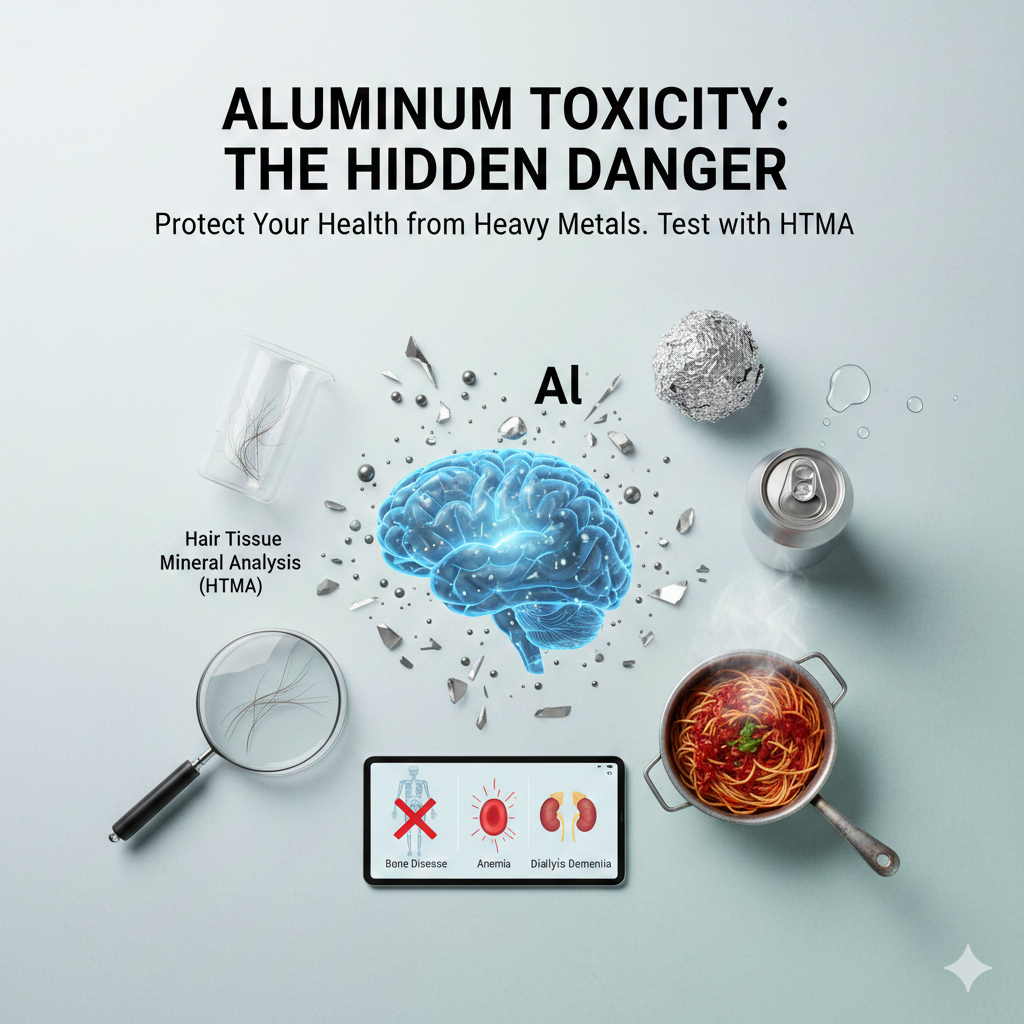The Dangers of Aluminum Toxicity: Aluminum Pans and Cans
The Dangers of Aluminum Toxicity
One of the first things we look for when we do hair tissue mineral analysis (HTMA) is heavy metals. Some of these are mercury, lead, cadmium, uranium, aluminum, and the like. These elements cause havoc in nerve tissues, muscle, bone, and just about anywhere they go in the body. Unfortunately, they tend to lodge or stay in the body and continue to cause problems. Did you know that large amounts of aluminum have been found in the brain tissue of Alzheimer’s patients? Many scientists think there is not a direct link with aluminum causing this disease, however, in my opinion, there is a direct link.
For the sake of this letter, let's talk about aluminum toxicity because it is the most abundant metal on the surface of our planet Earth and it is the cheapest to obtain and manufacture. More than 80% of all of our hardware products and many of our consumable products contain this dangerous metal.
Sources and Exposure
We can easily pick up aluminum from sources like cookware when this metal will leach out of the boiler or the pan and into the food. It is a very soft metal, and extreme chemical reaction can also occur between the food and the pan. The body derives no benefits from any amount of aluminum, and in larger quantities, its dangerous to most of our many functions. This leaching out of aluminum from the broiler or the foil or can will occur with any type of food. If the food is highly acid or base, like most colas and lemon/lime drinks, then more leaching occurs. For example, let's say you are making spaghetti sauce, which would tend to be more acid; 3 to 6 milligrams of aluminum have been found per 100 gram servings after being cooked in an aluminum pan. According to the Tree Hugger website, this is approximately 10 percent of the aluminum the average person consumes in a day. According to Dr. A. McGuigan’s Report on Findings for the Federal Trade Commission, “all vegetables cooked in aluminum produce hydroxide poison which neutralizes digestive juices, producing stomach and gastrointestinal trouble, such as stomach ulcers and colitis.” What also should be considered is the sale of aluminum cookware is prohibited in Germany, France, Belgium, the UK, Switzerland, Hungary, and Brazil. This is for good reason, and many Americans should take note of this.
Aluminum occurs in many over-the-counter medications and other consumable merchandise. It is found in many products like antacids, baking powder, and deodorants. Most people pick it up in their tissues from aluminum cans, pots, and pans.

The Problem with Carbonation and Aluminum
I quit drinking sodas years ago to avoid the cans and the carbonation. Yes, unfortunately, we will pick up aluminum in our body by drinking from aluminum cans. You ask why I avoid carbonation? Many people think that is strange, and I never hear anyone else talking about it, however, I don’t drink any kind of carbonated beverage. The main reason why is because carbonated beverages are not healthy is because our body’s are working 24/7 getting rid of carbonic acid. Our bloodstream brings carbonic acid to our lungs, and there it is converted to carbon dioxide, and we exhale. When we exercise, we increase this process. To really understand the urgency, our body is overloaded with carbonic acid. We can never get rid of it fast enough. This is how disease starts, not getting enough oxygen in the tissues because there is still too much carbon. So you can see what happens when you have too much carbonic acid and also get aluminum from drinking sodas. Plain and simple, it's just double trouble. Avoiding soda and staying physically fit by getting regular exercise will solve this problem.
Signs of Aluminum Toxicity and Health Concerns
You may think that aluminum is not that dangerous, or you may not ingest that much; well, think again. The numbers speak for themselves. In 2007, the Agency for Toxic Substances and Disease Registry cite aluminum is on the top priority list of toxins in the United States. It has been identified as a toxin for the human nervous system, immune system, and genetic system. Furthermore, 99 percent of ingested aluminum is excreted by the kidneys, except with patients with renal failure; in which aluminum retention within the body is responsible for “dialysis dementia.” In addition, dialysis patients often suffer from anemia and a specific form of metabolic bone disease, both due to aluminum retention. Anyway you look at it, the intake of aluminum is dangerous for everyone.
Signs of aluminum toxicity can be varied and often mimic other conditions, making a specific aluminum toxicity test like HTMA crucial for diagnosis.
Possible Bad Health and Illnesses Associated with Aluminum on the Human Body
Exposure to heavy metals like aluminum has been linked to a range of adverse health effects. A specific aluminum toxicity test can confirm elevated levels.
- Neurological Disorders: Linked to conditions like
Alzheimer's disease (accumulation in brain tissue), Parkinson's disease, and other neurodegenerative disorders.
- Bone Health: Associated with
metabolic bone disease (osteomalacia), decreased bone mineralization, and potential for fractures, especially in those with impaired kidney function.
- Anemia:
Aluminum can interfere with iron metabolism, leading to a specific type of anemia, particularly in patients on dialysis.
- Kidney Issues: The kidneys are responsible for excreting aluminum; chronic exposure or impairment can lead to
aluminum accumulation, causing
dialysis dementia in dialysis patients.
- Gastrointestinal Distress: Can neutralize digestive juices, potentially leading to conditions like
stomach ulcers and
colitis.
- Systemic Toxicity: It is a known toxin for the nervous system, immune system, and genetic system.
Contact Dr. Johnny to Schedule an HTMA
If you are concerned about your exposure to heavy metals like aluminum and are interested in pursuing a Hair Tissue Mineral Analysis (HTMA), you can contact Dr. Johnny directly. The HTMA is a non-invasive aluminum toxicity test that can provide valuable insight into your body's mineral and toxic metal levels.
Please reach out to schedule your analysis or for more information on the process.
Frequently Asked Questions About on Aluminum Toxicity
What is an "aluminum toxicity test," and why is it important?
An aluminum toxicity test is a method used to measure the amount of aluminum in the body. One method mentioned in the content is Hair Tissue Mineral Analysis (HTMA), which can reveal levels of heavy metals like aluminum that have accumulated in the body's tissues over time. It's important for identifying high exposure and determining if treatment is necessary to address the associated health risks.
What are the common household sources of aluminum exposure?
Common sources include aluminum cookware (pots, pans, broilers), food stored or cooked in aluminum foil, and beverages contained in aluminum cans. Additionally, many over-the-counter products, such as antacids, baking powder, and deodorants, contain aluminum compounds.
What are the key signs of aluminum toxicity?
Signs of aluminum toxicity can be subtle and non-specific but may include neurological symptoms (memory loss, confusion, muscle weakness), bone pain/disease, and anemia. In severe cases, especially in individuals with kidney failure, it can lead to dialysis dementia.
Does the content claim a direct link between aluminum and Alzheimer's disease?
The content states that large amounts of aluminum have been found in the brain tissue of Alzheimer’s patients and that the author, despite some scientists' reservations, believes there is a direct link between aluminum toxicity and the disease.
Why is aluminum cookware banned in certain countries?
Several countries, including Germany, France, and the UK, have prohibited or restricted the sale of aluminum cookware due to the risk of heavy metals leaching into food. This leaching can produce compounds that neutralize digestive juices and contribute to gastrointestinal issues.

Dr. Michael Rudulph Maxon, AKA Johnny Delirious, Laboratory Naturopathic Doctor, gives expert advice rooted in holistic healing principles, drawing on 40 years of professional experience in the health industry. He helps his patients recover and heal using food and Ancient Greek therapies, utilizing organic remedies that are all backed by modern laboratory science. He is unquestionably the only TRUE Addiction & Hepatitis A, B, and C Recovery Pioneer. Free of mood-altering substances (cocaine) since 1991, with no viral load or antibodies of hepatitis since 1994, and no cirrhosis since 1995. Nobody in his life—including doctors, friends, and family—thought he would live past 1992; they all said he was going to die. But, Johnny chose life, not death, and learned how to heal his body, mind, and spirit by developing new protocols with natural therapies, including the thoughtful application of homeopathic remedies where appropriate. For over 20 years, he has helped many others recover, including professionals like doctors, dentists, and lawyers, who prefer alternative medicine over chemical drugs or surgery to address the same conditions that everyone said were hopeless.
Contact Johnny for a Hair Tissue Mineral Analysis (HTMA) to get the right diet, supplements, and expert advice, benefiting from his 30 years of experience in these specialized protocols.
United States - 972-825-7912
http://www.johnnydelirious.com


